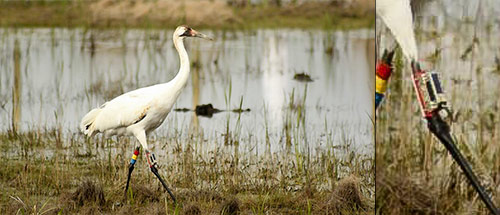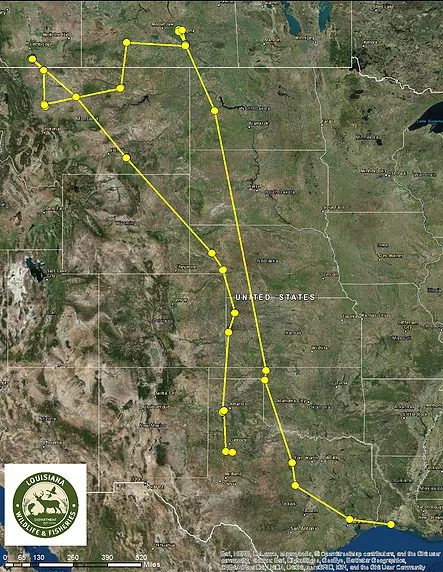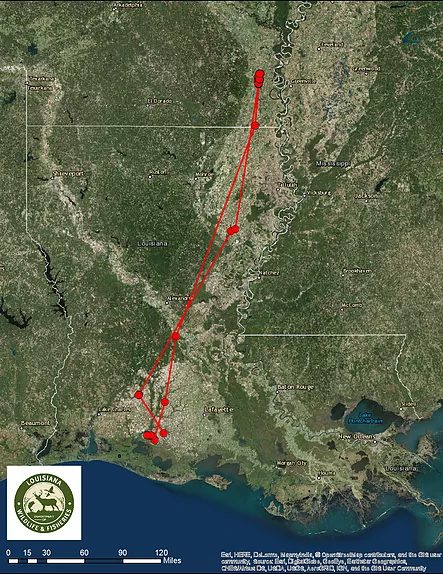← Back
Argos helps track large scale movements of Whooping Cranes reintroduced into Southwestern Louisiana

Whooping cranes were nearly extinct in North Americas in the 1950s. Preservation actions initiated since then have enabled the protection of the species. Reintroduction programs, helped by Argos satellite telemetry are now increasing the populations, and enabling new discoveries on those emblematic birds.
Whooping Cranes (Grus americana) are large birds that nest in fresh water wetlands. They lived throughout North America but declined beginning in the 19th century, due to wetland drainage, conversion of grassland to agricultural fields and hunting. They came perilously close to extinction, with only 21 birds remaining during the winter of 1942. Those birds were in two different sites, six in a non-migratory flock in southwestern Louisiana, which disappeared altogether by 1950. The others wintered in the Aransas National Wildlife Refuge, Texas where a population remains to this day, and have since increased. However, having only one site is dangerous for the preservation of the species, since this leaves them potentially susceptible to the same threats, for example a contagious disease, a chemical spill or a natural disaster. Establishing additional, separate, self-sustaining populations is a safeguard against a catastrophic loss of the remnant flock.
Reintroduction in a Louisiana historical site
In 2011, the Louisiana Department of Wildlife and Fisheries (LDWF), along with partners, established a population of Whooping Cranes in an area where they were historically present, the White Lake Wetlands Conservation Area in southwestern Louisiana. Each winter since then,additional juvenile cranes have been released there froming a non-migratory flock. Being non-migratory helps them avoid the dangers inherent in migrating, and from mixing with other existing populations.. With new juvenile birds released each year the population is slowlyincreasing; additionally the first hatches observed in the wild in Louisiana since 1939 occurred in 2016 with small numbers of chicks hatching in the wild each year since.
More info about birds tracking
Tracking the cranes
Each of the fifty birds in the first four cohorts received an Argos GPS satellite transmitter to allow close monitoring of movement and survival. Transmitters are programmed to collect three points per day and transmit the data every two days. Using these data, the cranes are tracked as they move around. Satellite telemetry also enables biologists to determine if the cranes move to an unsafe area at which point they may be captured and relocated, and if one should unfortunately die, the body would be recovered to determine the cause of death. As the cranes reached breeding age, transmitter data has also assisted biologists with monitoring nesting activity.
While most cranes remain in Southwestern Louisiana and eastern Texas, a few have made significant movements detected thanks to the Argos transmitters. Without the use of Argos enabled devices, these long-distance movements may not have been known or documented, as the focus of aerial and ground tracking is limited to a smaller geographic area where the majority of the cranes reside.
Long-distance flights
In May 2017, two males (only one with a functional transmitter) moved west into Texas before turning north and traveling approximately 2700 km to reach the Canadian province of Saskatchewan, a usual spring migration area for whooping cranes from a different population. In early June, the tracked crane flew farther west to southern Alberta. In mid-September, after almost three months in southern Alberta, transmitter data indicated he was on the move again on a trajectory towards southwestern Louisiana. He might have encountered migrating Sandhill Cranes somewhere in Nebraska or Kansas, as his trajectory changed slightly. He wintered with Sandhill Cranes in northwest Texas.
Transmitter data enabled Louisiana biologists to document that birds also travelled into Arkansas on three separate occasions, either young birds on exploratory flights, spending only a few nights there before returning to Louisiana, or older individuals settling there for almost three months before returning.
In late November 2017, a newly released juvenile female flew east, spending several weeks in the coastal marshes of Southeast Louisiana. Data indicated she initially began moving back west in early December, then turned and continued farther east and then north, eventually settling in southeastern Alabama. She returned to Louisiana in late January and departed again, this time to the west, in early May. Data indicates that she flew over the international border into the Mexican state of Coahuila before turning north and eventually settling in Wagoner County, Oklahoma where she remained for the summer. She then moved east again and wintered at the Wheeler National Wildlife Refuge in north-central Alabama, a major wintering location for thousands of sandhill cranes and about a dozen whooping cranes from an eastern migratory population. She returned to north Louisiana briefly in the spring before continuing west to Oklahoma for her second summer.
Contact the Argos team
Links
For more information on this project please visit http://www.wlf.louisiana.gov/wildlife/whooping-cranes
& Facebook page: https://www.facebook.com/lawhoopingcranes
Movie: https://www.youtube.com/watch?v=nsMuaKTrCbk&feature=youtu.be
CLS America User Story: https://www.clsamerica.com/whoopingcranes
Photo: A whooping crane with an Argos PTT on its right leg (Credit Louisiana Department of Wildlife and Fisheries)



